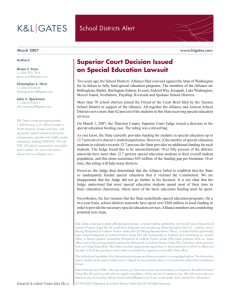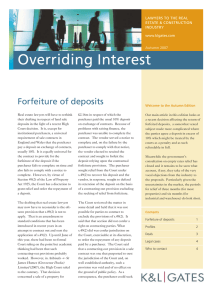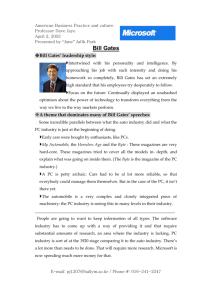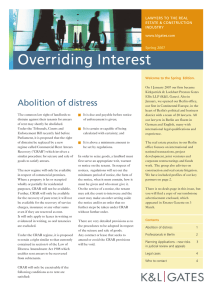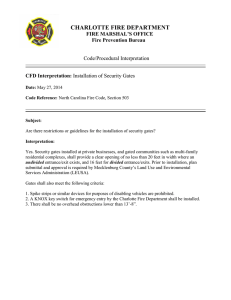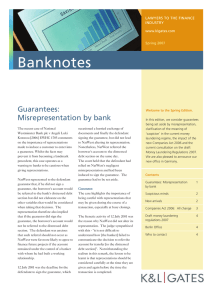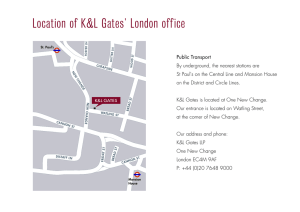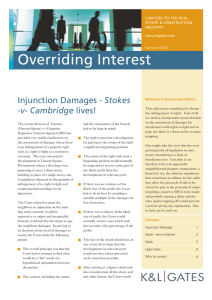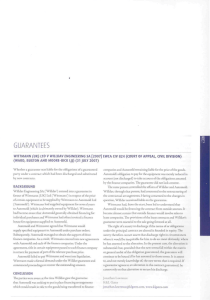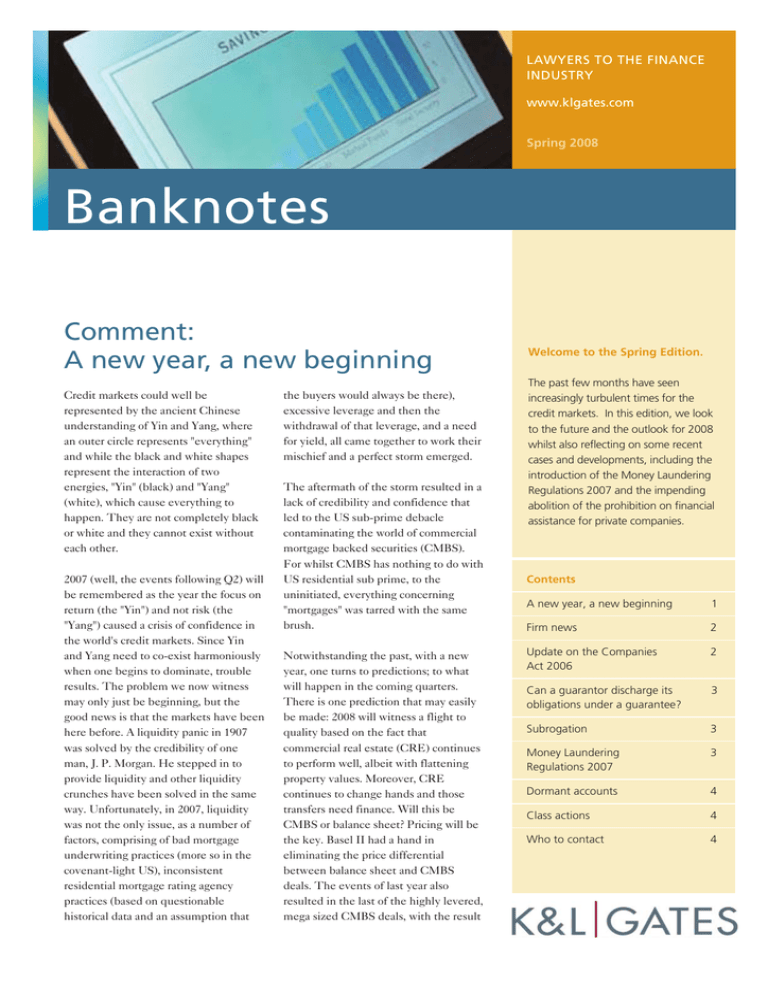
LAWYERS TO THE FINANCE
INDUSTRY
www.klgates.com
Spring 2008
Banknotes
Comment:
A new year, a new beginning
Credit markets could well be
represented by the ancient Chinese
understanding of Yin and Yang, where
an outer circle represents "everything"
and while the black and white shapes
represent the interaction of two
energies, "Yin" (black) and "Yang"
(white), which cause everything to
happen. They are not completely black
or white and they cannot exist without
each other.
2007 (well, the events following Q2) will
be remembered as the year the focus on
return (the "Yin") and not risk (the
"Yang") caused a crisis of confidence in
the world's credit markets. Since Yin
and Yang need to co-exist harmoniously
when one begins to dominate, trouble
results. The problem we now witness
may only just be beginning, but the
good news is that the markets have been
here before. A liquidity panic in 1907
was solved by the credibility of one
man, J. P. Morgan. He stepped in to
provide liquidity and other liquidity
crunches have been solved in the same
way. Unfortunately, in 2007, liquidity
was not the only issue, as a number of
factors, comprising of bad mortgage
underwriting practices (more so in the
covenant-light US), inconsistent
residential mortgage rating agency
practices (based on questionable
historical data and an assumption that
the buyers would always be there),
excessive leverage and then the
withdrawal of that leverage, and a need
for yield, all came together to work their
mischief and a perfect storm emerged.
The aftermath of the storm resulted in a
lack of credibility and confidence that
led to the US sub-prime debacle
contaminating the world of commercial
mortgage backed securities (CMBS).
For whilst CMBS has nothing to do with
US residential sub prime, to the
uninitiated, everything concerning
"mortgages" was tarred with the same
brush.
Notwithstanding the past, with a new
year, one turns to predictions; to what
will happen in the coming quarters.
There is one prediction that may easily
be made: 2008 will witness a flight to
quality based on the fact that
commercial real estate (CRE) continues
to perform well, albeit with flattening
property values. Moreover, CRE
continues to change hands and those
transfers need finance. Will this be
CMBS or balance sheet? Pricing will be
the key. Basel II had a hand in
eliminating the price differential
between balance sheet and CMBS
deals. The events of last year also
resulted in the last of the highly levered,
mega sized CMBS deals, with the result
Welcome to the Spring Edition.
The past few months have seen
increasingly turbulent times for the
credit markets. In this edition, we look
to the future and the outlook for 2008
whilst also reflecting on some recent
cases and developments, including the
introduction of the Money Laundering
Regulations 2007 and the impending
abolition of the prohibition on financial
assistance for private companies.
Contents
A new year, a new beginning
1
Firm news
2
Update on the Companies
Act 2006
2
Can a guarantor discharge its
obligations under a guarantee?
3
Subrogation
3
Money Laundering
Regulations 2007
3
Dormant accounts
4
Class actions
4
Who to contact
4
Banknotes
that going forward, CMBS deals will be
smaller in size and will be increasingly
tautology transparent. It is these CMBS
deals that, once investor confidence
returns (at the time of writing CMBS
deals are being priced in the market),
will have to compete with balance sheet
loans. But what must not happen is a
rush of deals in the market in a desire to
break the logjam. This may well
destabilise a fledgling recovery.
A knock on effect of 2007 is that 2008
should be associated with the sensible
pricing of risk (thus harmonising the Yin
and the Yang). No more should there be
an assumption that purchasers will
always be there to buy ever more
extravagant levered structured deals.
There should now be a focus (from
buyers and sellers) on analysing the
high risks associated with chasing high
yield. With this shift, we should all
begin to feel more comfortable.
Firm news
Continuing the firm’s European
expansion, we are pleased to announce
that in January 2008 we opened an office
in Paris. This complements K&L Gates’
significant London presence and
growing Berlin office which the firm
established in January 2007.
On 1 January 2008, the firm also
combined with Hughes & Luce LLP, a
150 lawyer Texas firm with offices in
Austin, Dallas and Fort Worth. This
makes K&L Gates a 1,500 lawyer firm
with 24 offices located throughout the
United States, Europe and Asia.
2
SPRING 2008
Update on the Companies Act
2006 - Financial Assistance
Although the implementation of certain
provisions of the Companies Act 2006
have now been delayed, the provisions
repealing the existing restrictions on
the giving of financial assistance by a
private company for the acquisition of
shares in itself or its holding company
are still due to be implemented on 1
October 2008.
The Companies Act 2006
(Commencement No. 5, Transitional
Provisions and Savings) Order 2007
made on 17 December 2007 includes a
saving provision to dispel doubts as to
whether the repeal of the financial
assistance provisions might fail to have
its intended effect because of the
application to transactions of the case
law deriving from Trevor v Whitworth
(1887) 12 App Cas 409. That case
ruled that a company cannot return
capital to its shareholders except by
one of the ways specifically authorised
by the Companies Acts.
Although the abolition of the
prohibition in section 151 for private
companies does not mean that any
previously applicable case law will be
revived, consideration needs to be
given to the fact that the rule in Trevor
v Whitworth is wider than the
prohibition in section 151 and may
therefore still apply to some
transactions.
An example of this is where a company
which has no or insufficient
distributable reserves makes a gift of
money to a shareholder with which to
purchase further shares in the
company. This transaction may fall
foul of the rule in Trevor v Whitworth
(notwithstanding the repeal of section
151) because it would result in an
unlawful reduction of capital by the
company. Similarly, a loan made by a
company with insufficient distributable
reserves to a shareholder, with a view to
that shareholder purchasing further
shares in the company at which time
the company was aware that there was
no reasonable prospect of the loan
being repaid, would continue to be
prohibited because it would give rise to
an unlawful reduction of capital.
Lenders should be aware that although
the statutory prohibitions on financial
assistance are to be abolished in
October, consideration will still need to
be given to the rule in Trevor v
Whitworth.
www.klgates.com
Money Laundering Regulations
2007
These regulations came into force on
15 December 2007. They increase the
regulatory burdens in areas of high risk
of money laundering and terrorist
financing and ease them in areas of low
risk.
By way of outline the regulations
provide for the following:
The provision of detailed
obligations regarding customer due
diligence including specific
requirements for firms to identify
not only the customer but the
beneficial owner of the customer
(and potentially the beneficial
owner of the beneficial owner) and
for firms to monitor their business
relationships on an ongoing basis.
The requirement for more detailed
checks on customers that pose a
higher risk of money laundering
including politically exposed
persons and customers that are not
met face to face.
The ability to take apply a risk
based approach to due diligence
and monitoring according to the risk
of money laundering.
Can a guarantor discharge its
obligations under a guarantee?
In the recent case of Wittmann (UK)
Limited v Willdav Engineering SA
[2007], Wittmann provided a guarantee
of its subsidiary company’s (A Ltd)
obligations under a contract for the
purchase of process equipment.
Subsequent to the provision of the
guarantee, and in order to finance the
purchase, A Ltd entered into tri-partite
agreements with the supplier (the
claimant) and three finance companies
who were to purchase the equipment
and lease it back to A Ltd. When A Ltd
failed to meet its full payment
obligations under the principal contract,
the claimant supplier sought payment
under the guarantee.
Wittmann claimed its obligations under
its guarantee had been discharged and
substituted by the new arrangements
with the finance companies. It argued
that the obligations under the new
contracts with the supplier were outside
the scope of the obligations envisaged
under its guarantee. The Court of
Appeal did not agree. The subsequent
finance arrangements did not sweep
away the original contract, nor
Wittmann's guarantee obligation, but
merely reduced A Ltd's and Wittmann's
obligations by an amount to take
account of the obligations assumed by
the finance companies. If the effect of
the financing transactions had been to
put in place a new contract with the
supplier, Wittmann's guarantee may
then have been discharged.
Comment
When varying a guaranteed obligation, it
is best practice to obtain the guarantor’s
consent to the variation. Whether that
consent is strictly required will depend
upon the nature of the variation (is it
material?) and the terms of the
guarantee. The rule in Holme v
Brunskill (1893) provides that a surety is
Subrogation
Andrew Conquest v Patrick McGinnis
and Another [2007] EWHC 2943 (Ch)
considered the equitable doctrine of
subrogation. Subrogation allows a
person who discharges the debt of
another person to step into the shoes of
the person who was originally entitled
to that debt and to receive the benefit
of any security held for that debt.
The court found that the doctrine of
subrogation was, on the face of it,
applicable to the allocation of surplus
funds following the finalisation of a
company's receivership because a
potential investor in the company had
discharged part of a secured debt of the
company in providing funds as security
for an overdraft. However, the
potential investor did not have any
beneficial entitlement to those surplus
funds because it was clear that he never
intended to become a secured creditor
himself and was aware of the risk that
monies he had advanced would not be
recoverable.
Comment
Where parties are hoping to rely on
rights of subrogation, it is advisable that
this be documented between the
potential investor and the borrower
(and potentially the original investor) at
the outset of the particular transaction.
discharged if the underlying contact is
varied unless he consents to the
variation. Whilst a clause in a guarantee
disapplying the rule in Holme v
Brunskill may be effective to preserve
the guarantee liability notwithstanding
variations, it may not be effective where
the purported guaranteed obligation is a
wholly new obligation not arising out of
the originally guaranteed obligation.
SPRING 2008
3
Banknotes
Dormant
accounts
It is estimated that £500 million is lying
in dormant bank and building society
accounts. This has prompted the
Government to set up a scheme under
which such balances can be distributed
for the benefit of the community whilst
ensuring that customers retain the right
to reclaim their money. This is in
contrast to the current system where
unclaimed money must remain in
dormant accounts indefinitely. In early
December 2007, the Dormant Bank
and Building Society Accounts Bill
entered the committee stage in the
House of Lords. Under the Bill, a
dormant account is defined as one
where there has been no customer
initiated transactions for 15 years.
Once a bank or building society
identifies a dormant account, it will
have the right to cancel its liability to
repay the money held in that account
to the customer if the money in
question is transferred to a reclaim fund
regulated by the Financial Services
Authority. Following the transfer, the
customer’s repayment right will be
against the reclaim fund rather than the
bank or building society. Any money
which the reclaim fund deems surplus,
having met anticipated levels of
customer reclaim, will be distributed by
the Big Lottery Fund for social and
environmental purposes.
Who to Contact
For further information contact Richard Hardwick
email: richard.hardwick@klgates.com
tel: +44 (0)20 7360 8125
Class actions - spreading to the UK?
In the US, an individual may bring a
class action on behalf of millions of
residents of a state or even the whole
country. Class counsel are able to
deploy the prospect of protracted
litigation as leverage to achieve
settlement. If the class obtains a
settlement or is awarded damages
(which can be substantial in the
aggregate but minimal for each class
member) the claimant’s attorney
typically retains a large percentage of
the award as a fee.
US-style class actions do not currently
feature in England and Wales but
collective claims could become more
prevalent. Banks may find themselves
on the receiving end of such claims or
may be lending to companies who face
such claims.
In 2006, the Government published a
consultation paper on extending the
scope of representative actions for
consumers. Submissions from parties
championing consumers in response to
that paper encouraged such claims.
Recent developments in the field of
Competition law illustrate how
collective claims, in other fields, might
be encouraged.
In November 2007, the Office of Fair
Trading produced recommendations to
make private competition law actions
more effective. These included
allowing claims be brought on behalf of
unnamed consumers and businesses
the ability for solicitors to enter into
conditional fee agreements with a
success fee of more than 100%; and for
the court’s cost capping powers to
include capping the defendant’s costs
at zero.
Provisions of the Companies Act 2006,
which came into force on 1 October
2007 may also encourage collective
claims as they give shareholders a
statutory right to bring derivative
actions on behalf of a company against
its directors for breach of duty. The
2006 Act also codified directors' duties.
It remains to be seen how these duties
are interpreted by the Courts and
whether the Act’s checks and balances
prevent unmeritorious claims.
A fuller version of this article first
appeared in the January/February issue
of PLC Magazine and is reproduced
with the kind permission of the
publisher.
K&L Gates
110 Cannon Street
London EC4N 6AR
www.klgates.com
K&L Gates comprises approximately 1,500 lawyers in 24 offices located in North America, Europe and Asia, and represents capital markets participants, entrepreneurs, growth and middle market
companies, leading FORTUNE 100 and FTSE 100 global corporations and public sector entities. For more information, please visit www.klgates.com.
K&L Gates comprises multiple affiliated partnerships: a limited liability partnership with the full name Kirkpatrick & Lockhart Preston Gates Ellis LLP qualified in Delaware and maintaining offices
throughout the U.S., in Berlin, and in Beijing (Kirkpatrick & Lockhart Preston Gates Ellis LLP Beijing Representative Office); a limited liability partnership (also named Kirkpatrick & Lockhart Preston
Gates Ellis LLP) incorporated in England and maintaining our London and Paris offices; a Taiwan general partnership (Kirkpatrick & Lockhart Preston Gates Ellis) which practices from our Taipei
office; and a Hong Kong general partnership (Kirkpatrick & Lockhart Preston Gates Ellis, Solicitors) which practices from our Hong Kong office. K&L Gates maintains appropriate registrations in
the jurisdictions in which its offices are located. A list of the partners in each entity is available for inspection at any K&L Gates office.
This publication/newsletter is for informational purposes and does not contain or convey legal advice. The information herein should not be used or relied upon in regard to any particular facts or
circumstances without first consulting a lawyer.
Data Protection Act 1998 - We may contact you from time to time with information on Kirkpatrick & Lockhart Preston Gates Ellis LLP seminars and with our regular newsletters, which may be of
interest to you. We will not provide your details to any third parties. Please e-mail london@klgates.com if you would prefer not to receive this information.
4
SPRING 2008
©1996-2008 Kirkpatrick & Lockhart Preston Gates Ellis LLP. All Rights Reserved.


